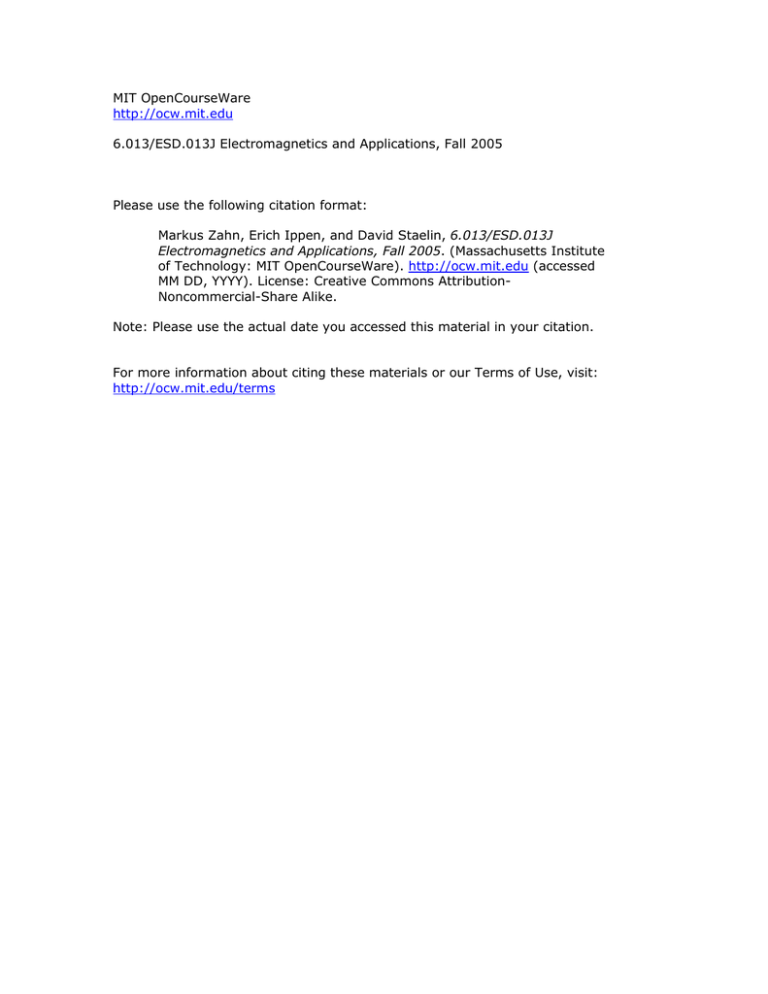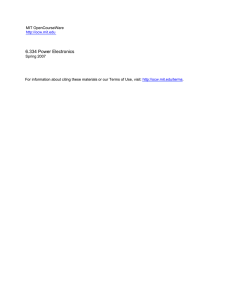MIT OpenCourseWare 6.013/ESD.013J Electromagnetics and Applications, Fall 2005
advertisement

MIT OpenCourseWare http://ocw.mit.edu 6.013/ESD.013J Electromagnetics and Applications, Fall 2005 Please use the following citation format: Markus Zahn, Erich Ippen, and David Staelin, 6.013/ESD.013J Electromagnetics and Applications, Fall 2005. (Massachusetts Institute of Technology: MIT OpenCourseWare). http://ocw.mit.edu (accessed MM DD, YYYY). License: Creative Commons AttributionNoncommercial-Share Alike. Note: Please use the actual date you accessed this material in your citation. For more information about citing these materials or our Terms of Use, visit: http://ocw.mit.edu/terms Massachusetts Institute of Technology Department of Electrical Engineering and Computer Science 6.013 Electromagnetics and Applications Problem Set #1 Fall Term 2005 Issued: 9/7/05 Due: 9/14/05 Reading Assignment: Sections 1.1 – 1.5, Appendices B, C of Electromagnetics and Applications Problem 1.1 – Coulomb Force Law a. View combined videos 1.3.1 (Coulomb’s Force Law and 1.5.1 (Measurement of Charge) at (http://web.mit.edu/6.013_book/www/VideoDemo.html). b. An electroscope measures charge by the angular deflection of two identical conducting balls suspended by an essentially weightless insulating string of length l. Each ball has mass M in the gravity field g and when charged can be considered a point charge. Adapted from Problem 2.6 in Electromagnetic Field Theory: A Problem Solving Approach, by Markus Zahn, 1987. Used with permission. A total charge Q is deposited on the two identical balls of the electroscope when they are touching. The balls then repel each other and the string is at an angle θ from the normal which obeys a relation of the form tan θ sin 2 θ = const c. What is the constant? Figure 1.5.5 in Electromagnetic Fields and Energy, by Hermann A. Haus and James R. Melcher, 1989. Conservation of charge requires that d ∫ J ida + dt ∫ ρ dV = 0 s V 2 where i = ∫ J ida is the terminal current and q = ∫ ρ dV is the total charge inside the s V volume V for the Faraday cage geometry shown above. If the instantaneous charge within the inner spherical volume is q (t ) , what is the voltage v across the load resistor R? Evaluate for q9t ) = q0 cos ωt . Problem 1.2 Figure 10.2.2 in Electromagnetic Fields and Energy, by Hermann A. Haus and James R. Melcher, 1989. a. View video 10.2.1, Edgerton’s Boomer at (http://web.mit.edu/6.013_book/www/VideoDemo.html). b. Use Ampère’s integral law over the contour C, shown above over a radius a equal to the average coil radius to approximate +1 due to the N turn toroidal coil carrying a current i. c. Estimate the coil self-inductance L. d. Neglecting the coil resistance, if the capacitor C is charged to voltage V, what is the coil current I and at what frequency f is it oscillating? e. If a metal disk of mass M is placed on the coil, when the charged capacitor at voltage V is discharged into the coil and if all losses are negligible, what is the maximum initial disk velocity v and to what height h will it go? f. Evaluate the coil self-inductance L of part c, coil current I and frequency f of part d, initial disk velocity v and height h in part e for parameters capacitance C = 25μ F , voltage V=4000 volts, N=50 turns, average coil radius a=7 cm. 3 Problem 1.3 A charge q of mass m with initial velocity v = v0i x is injected at x=0 into a region of uniform electric field E = E0 iz . A screen is placed at the position x=L. At what height h does the charge hit the screen? Neglect gravity. Problem 2.8 in Electromagnetic Field Theory: A Problem Solving Approach, by Markus Zahn, 1987. Used with permission. Problem 1.4 a. View H/M video 1.4.1, Magnetic Field of a Line Current, at (http://web.mit.edu/6.013_book/www/VideoDemo.html) where the magnetic field strength is measured by a Hall effect probe. This probe works by the principle that when charges flow perpendicular to a magnetic field, the transverse displacement due to the Lorentz force can give rise to an electric field. Figure 5.6 in Electromagnetic Field Theory: A Problem Solving Approach, by Markus Zahn, 1987. Used with permission. A magnetic field perpendicular to a current flow deflects the charges transversely giving rise to an electric field and the Hall voltage. The polarity of the voltage is the same as the sign of the charge carriers. 4 b. A uniform magnetic field B = Bo iz = μo H o iz is applied to a material carrying a current in the y direction. For positive charges, as for holes in a p-type semiconductor, the charge velocity v = v y iy is in the positive y direction, while for negative charges as typically occur in metals or in n-type semiconductors, the charge velocity vy is negative. In the steady state, the charge velocity vy does not vary with time so the net force on the charges must be zero. What is the electric field (magnitude and direction) in terms of vy and Bo? c. What is the Hall voltage, VH = Φ( x = d ) − Φ ( x = 0) = −Ex d in terms of vy, Bo and d? d. Can this measurement determine the polarity of the charge carriers assuming that the current i is positively y-directed and B0 is positively z-directed? y Problem 1.5 I1 d x I2 a. Two line currents of infinite extent in the z direction are a distance d apart along the yaxis. The current I1 is located at y=d/2 and the current I2 is located at y=-d/2. Find the magnetic field (magnitude and direction) at any point in the y=0 plane and for any point the z=0 plane. Hint: In cylindrical coordinates 1 1 iφ 1 = ⎡⎣ −( y − d ) ix + xiy ⎤⎦ / ⎡⎣ x 2 + ( y − d ) 2 ⎤⎦ 2 ; iφ 2 = ⎡⎣ −( y + d ) ix + xiy ⎤⎦ / ⎡⎣ x 2 + ( y + d ) 2 ⎤⎦ 2 b. Find the force per unit length on I1. c. For what values of I1 / I 2 are H x( x, y = 0) = 0 or H y ( x, y = 0) = 0 ? 5



